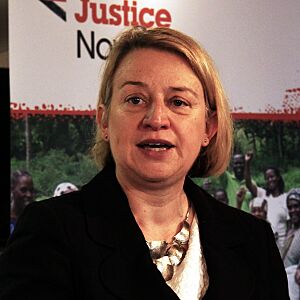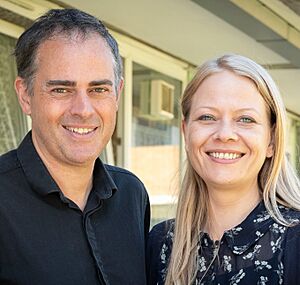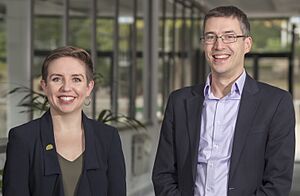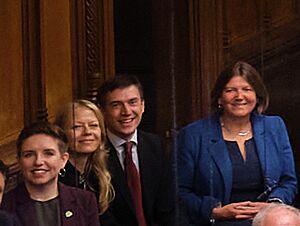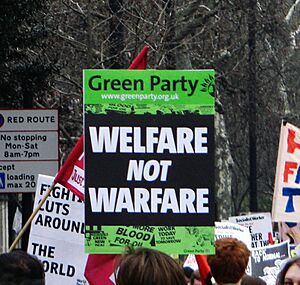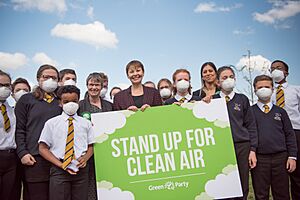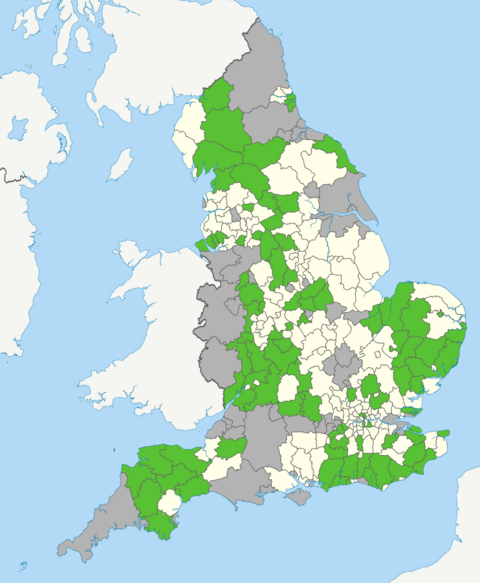Green Party of England and Wales facts for kids
Quick facts for kids
Green Party of England and Wales
Plaid Werdd Cymru a Lloegr
|
|
|---|---|
 |
|
| Abbreviation | GPEW |
| Co-leaders | Carla Denyer Adrian Ramsay |
| Deputy Leader | Zack Polanski |
| Chair | Jon Nott |
| Founded | July 1990 |
| Preceded by | Green Party (UK) |
| Headquarters | PO Box 78066, London SE16 9GQ |
| Youth wing | Young Greens of England and Wales |
| LGBT wing | LGBTIQA+ Greens |
| Membership (June 2025) | |
| Ideology | Green politics Progressivism Factions: Anti-capitalism Eco-socialism |
| Political position | Left-wing |
| European affiliation | European Green Party |
| International affiliation | Global Greens |
| Colours |
|
| Devolved branches | Wales Green Party London Green Party |
| House of Commons |
4 / 575
(England and Wales) |
| House of Lords |
1 / 777
|
| Senedd |
0 / 60
|
| London Assembly |
3 / 25
|
| Directly elected regional mayors in England |
0 / 14
|
| Directly elected single authority mayors in England |
0 / 13
|
| Councillors |
867 / 17,419
(England and Wales) |
| Councils led |
12 / 338
(England and Wales) |
| PCCs and PFCCs |
0 / 37
|
| Election symbol | |
 |
|
The Green Party of England and Wales (often called the Green Party or Greens) is a political party in England and Wales. It focuses on environmental issues and left-wing ideas. Since October 2021, Carla Denyer and Adrian Ramsay have been the party's co-leaders. The party currently has four members in the House of Commons and two in the House of Lords. They also have over 850 councillors in local councils and three members in the London Assembly.
The party's main ideas combine caring for the environment with left-wing economic plans. These include well-funded public services that are controlled locally. They support an economy that stays stable, with rules for capitalism. They also want a voting system called proportional representation. The party supports progressive social policies. These include civil liberties, animal rights, and LGBT rights. They also support a universal basic income and a living wage. The party is part of the Global Greens and the European Green Party.
In 1990, the UK-wide Green Party (which started as the PEOPLE Party in 1973) split. This created the Green Party of England and Wales, the Scottish Greens, and the Green Party Northern Ireland. These are now separate political parties. The Green Party of England and Wales focused on growing its support in local areas during the 1990s. In 2010, the party elected its first MP, Caroline Lucas. The Green Party supports changing the UK's first-past-the-post voting system to proportional representation. This would give all parties a fair share of seats in Parliament based on their national votes. The party gained more support in 2025 from voters who were not happy with the Labour Party.
Contents
The Green Party's Journey
How the Party Started (1972–1990)
The Green Party of England and Wales began as the PEOPLE Party in November 1972 in Coventry. It changed its name to the Ecology Party in 1975. In 1985, it became the Green Party. In 1989, the Scottish branch became the independent Scottish Green Party. The Green Party in Northern Ireland is linked to the Green Party of the Republic of Ireland. This led to the branches in England and Wales forming their own party.
In the 1989 European Parliament elections, the Green Party received 15% of the votes. This was 2.3 million votes, their best result in a national election at that time. They had the third-largest share of votes. However, because of the first-past-the-post voting system, they did not win any seats. Many people believe this success was due to more interest in environmentalism.
Early Years and Growth (1990–2008)
After the 1989 European elections, a group called Green 2000 formed in 1990. They wanted to change the party's structure to win more seats in Parliament. These changes included a more central leadership. Some members disagreed and left the party. However, the changes were approved in 1991. The party then focused on winning local elections.
In 1993, Caroline Lucas won a seat on Oxfordshire County Council. More local wins followed in 1995 and 1996. The Greens also tried to work with other parties. In Wales, they supported Plaid Cymru candidate Cynog Dafis in the 1992 general election. He was elected on a joint ticket.
When the Labour Party moved more towards the middle ground, the Greens tried to attract voters who felt left out.
In the 1999 European Parliament elections, the UK used proportional representation for the first time. This helped the Greens win their first Members of the European Parliament (MEPs): Lucas and Jean Lambert. In the 2000 London Assembly elections, the party won three seats.
In the 2005 general election, the party received over 1% of the national vote for the first time. This growth was partly because the party became more visible to the public.
Caroline Lucas as Leader (2008–2012)
In 2007, the party decided to have a "leader" and "deputy leader" instead of two "principal speakers." In September 2008, Caroline Lucas became the first leader, with Adrian Ramsay as deputy. In the 2009 European elections, the party kept both its MEPs.
In the 2010 general election, Lucas became the first Green MP, winning the seat of Brighton Pavilion. In the 2011 local elections, the Green Party took control of the City Council in Brighton and Hove, but without an overall majority.
Natalie Bennett as Leader (2012–2016)
In 2012, Natalie Bennett became the party leader. She aimed to make the party more focused on anti-austerity policies.
The 2013 local elections saw the Greens gain five seats. They also won seats for the first time in Cornwall, Devon, and Essex. In the 2014 local elections, they gained 18 seats.
In the 2014 European elections, the Green Party came in fourth place. They won over 1.2 million votes and gained one more MEP seat.
In December 2014, the Green Party's membership more than doubled to over 30,000. This quick increase in support was called the "Green Surge" by the media. By January 2015, the combined Green Party membership in the UK was over 44,000.
In the 2015 general election, Lucas was re-elected in Brighton Pavilion with more votes. The party did not win any other seats. However, they received their highest-ever number of votes (over 1.1 million) and increased their national vote share to 3.8%. After the election, membership grew to over 63,000.
Lucas and Bartley as Co-leaders (2016–2018)
In May 2016, Natalie Bennett announced she would not seek re-election. Two weeks later, former leader Lucas and Jonathan Bartley announced they would run as co-leaders. They were elected in September 2016.
Lucas suggested "progressive pacts" to work on issues like climate change and electoral reform. After the vote to leave the European Union in June 2016, Bennett called for an "anti-Brexit alliance" with other parties. In the 2017 general election, the Green Party stood in 457 seats. They received 1.6% of the total vote. Brighton Pavilion remained Green with an increased majority.
In May 2018, Lucas announced she would step down as co-leader. Bartley then announced he would run for co-leader with Siân Berry.
Bartley and Berry as Co-leaders (2018–2021)
Bartley and Berry were elected as co-leaders in September 2018. In the 2019 local elections, the Green Party had its best local election result ever. They more than doubled their number of council seats to 372. This was followed by a successful European election. The Greens won over two million votes and secured 7 MEPs, up from 3. Membership also increased to 50,000 in September 2019.
In September 2020, Bartley and Berry were re-elected as co-leaders. In the 2021 local elections, the Green Party gained 88 seats. This made them a strong challenger to the Liberal Democrats as England's third-largest party.
In July 2021, Bartley announced he would step down. Berry remained as acting leader but decided not to run in the next leadership election.
Denyer and Ramsay as Co-leaders (2021–Present)
Carla Denyer and Adrian Ramsay were elected as co-leaders on 1 October 2021. Ramsay said that "People are looking for a positive alternative to the establishment parties." In the 2022 local elections, the Green Party gained 71 seats.
On 7 September 2022, Zack Polanski was elected as the party's new deputy leader.
In October 2022, the Scottish Greens voted to end their formal cooperation with the Green Party of England and Wales. The Green Party of England and Wales stated that they support the rights of all people and aim to be welcoming and inclusive.
At the 2023 local elections, the Green Party gained over 200 councillors. They won majority control of Mid Suffolk District Council for the first time. This was the party's best local election result ever.
In the 2024 local elections, the Greens gained 74 seats across England. They became the largest party on Bristol City Council. They also won their first seats on Newcastle City Council and Sefton Council. This was hailed as their best local election result ever.
On 8 June 2023, Caroline Lucas announced she would not stand for re-election in the 2024 general election. Former co-leader Siân Berry stood in Brighton Pavilion and won. Denyer gained Bristol Central, Ramsay won Waveney Valley, and Ellie Chowns won North Herefordshire. This was the Greens' best general election result ever, with four MPs elected.
Carla Denyer is stepping down as Green Party co-leader to focus on her MP role. Leadership nominations opened on 2 June 2025, with voting through August 2025. Results will be announced on 2 September 2025. Deputy leader Zack Polanski has announced his bid for leadership.
Party Ideas and Plans
The Green Party believes in "an economy that works for all." They want to end poverty by increasing the minimum wage to a living wage. In October 2021, they supported a £15 an hour minimum wage. The party also supports moving towards a four-day work week.
In November 2019, the Greens promised to introduce a universal basic income by 2025. This would give every adult in the UK at least £89 a week. This aims to fight poverty and give people more financial security.
The Green Party wants to raise corporation tax to ensure large companies pay their fair share. They want to end money given to fossil fuels and instead support renewable energy sources like wind and solar power. They believe investing in green energy can create more jobs. The party also supports a nationwide program to insulate homes. This would reduce energy use and lower bills.
The party supports bringing energy and water companies, public transport, and Royal Mail under public ownership. They also want social care to be free for everyone.
Caring for the Environment
The Green Party wants to bring water companies into public ownership. This would lower water bills and use money for repairs and clean water. They also want to set new air quality standards and increase forests and green spaces.
The party aims to stop tax breaks for fossil fuels and close coal power stations. They would also stop supporting nuclear power within ten years. Instead, they would invest in renewable energy sources like wind, solar, and hydropower. They want the UK to become carbon neutral.
The Green Party wants to create an environmental protection committee. This committee would protect natural habitats and increase biodiversity. The party also wants to ban trophy hunting and trail hunting.
Global Relations and Safety
Since 1992, the party has called for the UK to get rid of its Trident nuclear missile programme. They have worked with groups like the Campaign for Nuclear Disarmament (CND) on this issue.
The party opposed the UK's involvement in the War in Afghanistan and the invasion of Iraq. They also oppose British involvement in the Saudi Arabian–led intervention in Yemen.
The party supports the rights of indigenous people around the world. They believe in giving these groups more control over their own lives. They also support cancelling international debt for poorer countries.
The Green Party wants the Western world to be less controlling. They advocate for countries to be more self-sufficient in food and energy.
Fairness for All
The Green Party has a group called LGBTIQA+ Greens. This group works to raise awareness about LGBTIQA+ rights and issues affecting the wider LGBTIQA+ community. They aim to promote equality and fairness for all people.
The party supports same-sex marriage. They also support policies that ensure all teachers are trained on LGBTIQA+ issues.
Travel and Transport
The Green Party wants a "People's Transport System" to help the planet and local communities. They aim to make transport accessible for everyone, regardless of age, wealth, or disability. They also want to reduce how far people travel by supporting local facilities.
The party would follow a green transport hierarchy:
- Walking and disabled access.
- Cycling.
- Public transport (trains, trams, buses, ferries).
- Light goods vehicles, taxis, and low-powered motorcycles.
- Private cars and high-powered motorcycles.
- Heavy goods vehicles.
- Aeroplanes.
A key policy is to bring the railways back into public ownership.
The party initially opposed High Speed 2 (HS2) but later voted to support building the full project in September 2024. They believe high-speed rail can reduce short domestic flights.
Education Costs
The party supports getting rid of university and further education fees. They believe all courses in further education should be free. They also want to cancel existing student debts for undergraduate tuition and maintenance loans.
How Government Works
The party wants more accountability in global governance. They want the United Nations to have elected representatives. They also want democratic control of the global economy.
At a national level, the party wants to end the first past the post voting system for UK elections. They want to replace it with proportional representation. They also believe there should be "no place in government for the hereditary principle," meaning the monarchy should not have government roles.
The party supports the separation of church and state. They want the Church of England to be separate from the British state.
The party supported Scottish independence in the 2014 Scottish independence referendum. In February 2021, the Green Party announced support for a referendum on Welsh independence. Their general policy is to support the self-determination of Scotland, Wales, and Northern Ireland if they wish to leave the UK.
Party Structure
The Green Party has two main governing bodies: the Green Party Executive (GPEx) and the Green Party Regional Council. The GPEx handles daily party matters and finances. The GPRC deals with broader political strategy and policy between party conferences.
Groups within the Party
There are several groups linked to the Green Party:
- The Young Greens of England and Wales is the youth wing for members up to 30 years old or in education. They have their own constitution and campaigns.
- Other groups include:
- Association of Green Councillors
- Greens for Animal Protection
- Greens of Colour
- Green Party Disability Group
- Feminist Greens
- Jewish Greens
- Green Left
- LGBTIQA+ Greens
- Green Seniors
- Green Party Trade Union Group
- Green Party Women
Membership and Money
The Green Party relies more on money from its members than other parties. In 2014, membership fees made up 23% of their income. Professor Catherine Rowett explained that "Money pays for leaflets, campaigns, staff time. We run a clean campaign with money from our members."
Membership grew quickly in 2014, more than doubling. By January 2015, the combined membership of the UK Green Parties was over 43,000. This made it the third-largest UK-wide political party by membership at the time. Membership peaked at over 67,000 in summer 2015.
| Year |
|
|---|---|
| 2002 |
5,268
|
| 2003 |
5,858
|
| 2004 |
6,281
|
| 2005 |
7,110
|
| 2006 |
7,019
|
| 2007 |
7,441
|
| 2008 |
7,553
|
| 2009 |
9,630
|
| 2010 |
12,768
|
| 2011 |
12,842
|
| 2012 |
12,619
|
| 2013 |
13,809
|
| 2014 |
30,900
|
| 2015 |
63,219
|
| 2016 |
45,643
|
| 2018 |
39,350
|
| 2019 |
50,000
|
| 2021 |
54,306
|
| 2022 |
53,126
|
| July 2024 |
59,000
|
| March 2025 |
60,000
|
Who Supports the Greens?
The Green Party gets support from many different people. In 1995, sociologist Chris Rootes said the party appealed more to younger, highly educated professionals. However, he noted that this support was not mainly from cities. In 2009, Sarah Birch noted that the Greens were strongest in university towns or urban areas with many students.
Party Spokespeople
The Green Party has several spokespeople appointed by its Green Party Executive Committee.
| Role | Spokesperson | Notes |
|---|---|---|
| Co-Leaders | Carla Denyer | Bristol City Councillor for the party from 2015 to 2024. MP for Bristol Central since July 2024. |
| Adrian Ramsay | Former deputy leader of the party from 2008 to 2012 and Norwich City Councillor for the party from 2003 to 2011. MP for Waveney Valley since July 2024. | |
| Deputy Leader | Zack Polanski | London Assembly Member for the party since 2021. |
| Wales Leader | Anthony Slaughter | First elected as the leader of the Wales Green Party in December 2018. Re-elected in December 2021. |
| Culture, Sport and Digital Inclusion | Jack Lenox | Councillor in Lancaster |
| Democracy and Citizen Engagement | Nate Higgins | Councillor in Newham |
| Disability | Mags Lewis | Environmental and disability activist from Leicester |
| Equalities and Diversity | Ria Patel | Councillor in Croydon |
| Finance and Economy | Molly Scott Cato | Former MEP (South West) for the party from 2014 to 2020. |
| Food, Agriculture & Rural Welfare | Emily O'Brien | Councillor in Lewes |
| Global Solidarity | Carne Ross | |
| Green New Deal | Zoe Nicholson | Councillor in Lewes |
| Health, Social Care and Public Health | Dr Pallavi Devulapalli | Councillor on the Borough Council of King's Lynn and West Norfolk |
| Housing and Communities | Ellie Chowns | Councillor in Herefordshire from 2017 to 2024 and former MEP (West Midlands) for the party from 2019 to 2020. MP for North Herefordshire since July 2024. |
| Lifelong Education | Vix Lowthion | |
| Migration and Refugee Support | Benali Hamdache | Councillor in Islington |
| Natural World | Jonathan Elmer | Councillor in Durham |
| Peace and Global Justice | Shahin Ashraf | |
| Policing and Domestic Safety | Amanda Onwuemene | Councillor in Birkenhead |
| Transport and Healthy Streets | Matt Edwards | Councillor in Bradford |
| Work, Employment and Social Security | Professor Catherine Rowett | Councillor in Norfolk since July 2023 and former MEP (East of England) for the party from 2019 to 2020. |
Election Results and Representatives
The Green Party has four members in the House of Commons, two members in the House of Lords, and three members in the London Assembly. They also have hundreds of councillors elected at the local level.
House of Commons Seats
Brighton Pavilion was the Green Party's first seat, won in the 2010 general election. It has been held by the party in every election since. In 2024, the party won three more seats: Bristol Central, North Herefordshire, and Waveney Valley. The first-past-the-post voting system makes it hard for smaller parties to win many seats.
| Election | Leader(s) | Votes | Seats | Government | ||||
|---|---|---|---|---|---|---|---|---|
| # | % | ± | # | ± | ||||
| 1992 | Jean Lambert | Richard Lawson | 170,047 | 0.5 |
0 / 650
|
Conservative | ||
| 1997 | Peg Alexander | David Taylor | 61,731 | 0.3 |
0 / 659
|
Labour | ||
| 2001 | Margaret Wright | Mike Woodin | 166,477 | 0.6 |
0 / 659
|
Labour | ||
| 2005 | Caroline Lucas | Keith Taylor | 257,758 | 1.0 |
0 / 646
|
Labour | ||
| 2010 | Caroline Lucas | 265,247 | 0.9 |
1 / 650
|
Conservative–Liberal Democrats | |||
| 2015 | Natalie Bennett | 1,111,603 | 3.8 |
1 / 650
|
Conservative | |||
| 2017 | Caroline Lucas | Jonathan Bartley | 512,327 | 1.6 |
1 / 650
|
Conservative minority with DUP confidence & supply |
||
| 2019 | Siân Berry | 835,589 | 2.6 |
1 / 650
|
Conservative | |||
| 2024 | Carla Denyer | Adrian Ramsay | 1,841,888 | 6.7 |
4 / 650
|
Labour | ||
House of Lords Members
The party's first member in the House of Lords was Baron Beaumont of Whitley, who joined in 1999. Baroness Jones of Moulsecoomb became the next Green peer in 2013. Former party leader Baroness Bennett of Manor Castle joined her in 2019.
European Parliament Members
The Green Party of England and Wales has had members in the European Parliament since 1999. In May 2019, the number of Green MEPs rose to seven.
| Election | Leader(s) | Votes | Seats | Position | ||||
|---|---|---|---|---|---|---|---|---|
| # | % | ± | # | ± | ||||
| 1994 | John Cornford | Jan Clark | 471,257 | 3.0 |
0 / 87
|
|||
| 1999 | Mike Woodin | Jean Lambert | 568,236 | 5.3 |
2 / 87
|
|||
| 2004 | Mike Woodin | Caroline Lucas | 948,588 | 5.6 |
2 / 78
|
|||
| 2009 | Caroline Lucas | 1,223,303 | 7.8 |
2 / 72
|
||||
| 2014 | Natalie Bennett | 1,136,670 | 6.9 |
3 / 73
|
||||
| 2019 | Jonathan Bartley | Siân Berry | 1,881,306 | 11.8 |
7 / 73
|
|||
Local Government Presence
The party has members in local councils across England and Wales. Their first local mayor was Peter Christie in Bideford in 1985.
From the early 1990s to 2009, the number of Green local councillors grew to over 100. In 2011, the party led a council for the first time in Brighton and Hove City Council. In July 2020, the Green Party again took control of Brighton.
The 2023 United Kingdom local elections saw the Greens win an overall council majority for the first time on Mid Suffolk District Council. After the 2024 United Kingdom local elections, the Greens led coalitions on 12 councils. They were also part of coalitions running more than two dozen others.
Since 2017, the party has increased its number of councillors in every election. After the 2025 local elections, they reached a record high of 859 seats on 181 different councils.
Current and Former Representatives
House of Commons
-
Siân Berry MP (Brighton Pavilion), 2024–present
House of Lords
-
Baroness Bennett of Manor Castle, 2019–present
Former Representatives
House of Commons
- Cynog Dafis MP (Ceredigion), 1992–2000 (ran on a Joint Ticket with Plaid Cymru and was a member of the Green Party until 1997. Caroline Lucas is usually considered the first Green MP for this reason)
- Caroline Lucas MP (Brighton Pavilion), 2010–2024
House of Lords
- George MacLeod, Baron MacLeod of Fuinary, 198?–1991
- Baron Beaumont of Whitley, 1999–2008 (originally a peer for Liberals between 1967 and 1988 and Lib Dems between 1988 and 1999)
More to Explore
- Anti-nuclear movement in the United Kingdom
- Bright Green
- Green Left (England and Wales)
- Greens Organise
- List of British republicans
- List of green political parties
- Politics of the United Kingdom
See also
 In Spanish: Partido Verde de Inglaterra y Gales para niños
In Spanish: Partido Verde de Inglaterra y Gales para niños





